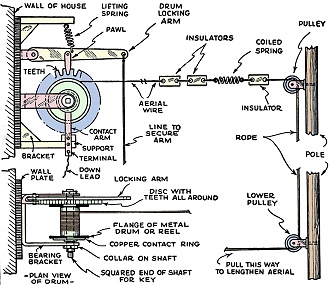A Variable Wavelength Antenna
|
|||||||||||||||||||
There are many designs for multiple-wavelength antennas available. Some use resonant "traps" and specific length sections of lines to change the effective RF length according to specific frequency bands, and others employ complex phasing of multiple antennas to a single-point feed. Doing so allows operation across bands that do not necessarily fall within or close enough to harmonic ratios, while still presenting decent VSWR to the transceiver for acceptable performance. Still, nothing beats a single, finely tuned antenna for each band of operation, or for that matter an antenna whose length is trimmed to operate at peak efficiency even within sub-bands. It is possible to "match" just about any antenna impedance to a transmission line and transceiver, there will always be loses in efficiency and thus loss in power due to resistive losses in matching networks and transmission lines (where reflected power is dissipated). This arrangement of a continuously variable length wire antenna is one answer to the problem. It takes a bit of mechanical aptitude and a willingness to adjust the length with each frequency change, but after the initial calibration you simply adjust it to marked points. Designing a fully automatic electromechanical version is well within the skill set of many Hams. A Variable Wavelength Antenna
In the early days of short-wave reception every amateur dreamed of having efficient tuning condensers which would be smoothly and silently variable; then came the variable grid-leak, volume control, and now variable-mu valves. This desire to have various features of variable value has caused attention to be directed to the aerial used for short-wave reception, the idea being to have the aerial of such a length that it favors a certain wavelength or band of wavelengths. The natural wavelength of any aerial depends primarily on its length, and the wavelength (in meters) can be found by multiplying its length in feet by 0.3 and the result by 4. For example, an aerial 50 feet long has a natural wavelength of 50 x 0.3 x 4 = 60 meters, or, if we wish to know what length of wire to use in order to obtain a given natural wavelength, we must multiply the number in meters by 3.3 and divide the result by 4. Thus, if we require an aerial with a natural wavelength of 30 meters, the length of wire required will be (30 x 3.3) / 4 = 24.75 feet or 24 feet 9 inches.
The free end of the aerial wire is provided with two egg-type insulators, a coiled spring and another insulator, to which is attached the hauling rope or line which passes over the top pulley - fixed to the usual wireless pole at the far end of the garden - down the pole, round the lower pulley and thence back to the house where it is secured, within easy reach. With the aerial extended to 14 feet - equivalent to a natural wavelength of 16.8 meters by the formulae given - the Empire transmitter for the African zone was picked up at fair loudspeaker strength but subject to fading. Extending the aerial another 9 feet gave a length of 23 feet, corresponding to a natural wavelength of 27.6 meters. The same transmission was tuned in again and found to be louder, with fading not so deep. The volume dropping to a comfortable loudspeaker strength, while the peak strength between fades was much greater than ever obtained before. Experiments on other parts of the waveband have shown that reception is improved by adjusting the length of the aerial. - World Radio. (In this article the author referring to "natural wavelength" means the greatest wavelength at which a grounded antenna will function. In his meter-to-feet conversion he uses 3.3 as a factor instead of 3.28. These calculations are near enough for "receiving" purposes but will not serve for computing dimensions of transmitting antennas. - Editor)
Posted January 17, 2024 |
|||||||||||||||||||

